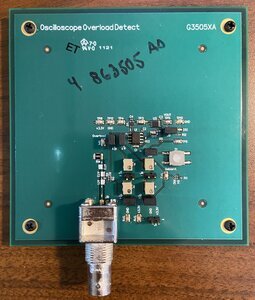
This overload detection system is used to detect when a user applies a voltage that is too high to the 50 Ohm input of an oscilloscope so that the internal relays can be switched off to prevent damage to the oscilloscope. This ECE Senior Design Capstone project is a prototype for a circuit that is intended for use in Tektronix oscilloscopes. This project is done in hardware only, with no embedded programming, in order to improve detection speed. Some specifications for this project were that it should detect voltages greater than 7 V as an overload within 2 seconds.
A key technology used is temperature sensing. A thermistor is thermally coupled to the oscilloscope input trace, and another thermistor is used to detect ambient temperature. Temperature sensing is used since directly measuring the voltage would introduce noise. The temperature is used to detect overloads in two ways. First, the input temperature is compared to ambient temperature, and when a high voltage is applied the heat generated creates a great enough difference between the two to signify an overload. The second method is detecting the speed at which the input temperature changes, since the temperature will increase more quickly for higher voltages.
The primary accomplishment of this project is a working prototype that was tested in a temperature controlled chamber from 0 to 50 °C. A major challenge was properly calibrating the temperature sensors to work quickly enough without providing false detections over the temperature range. A future improvement is to increase the speed of the system through better calibrated ramp detection.
| Attachment | Size |
|---|---|
| 103.54 KB |

